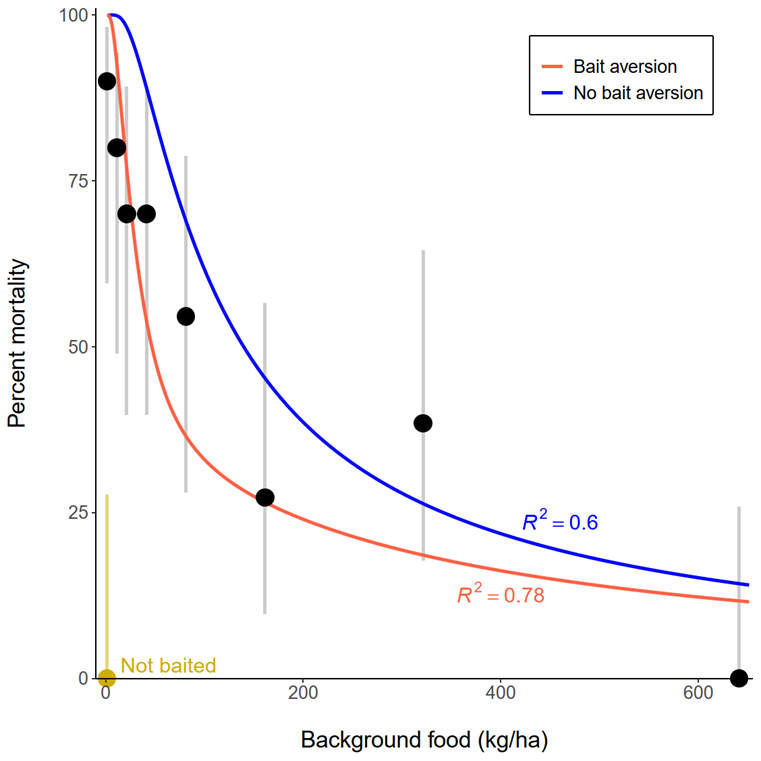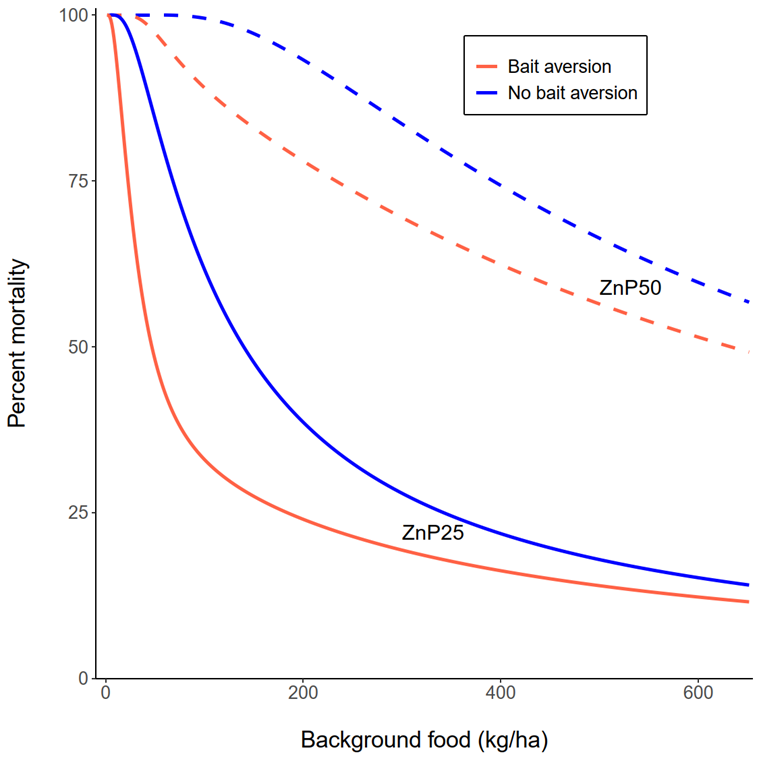Strategic use of zinc phosphide is critical for successful mouse control
Strategic use of zinc phosphide is critical for successful mouse control
Author: Steve Henry, Lyn Hinds, Wendy Ruscoe, Peter Brown, Nikki Van de Weyer, Freya Robinson (CSIRO Health and Biosecurity, Canberra), Richard Duncan (University of Canberra) | Date: 06 Feb 2024
Take home messages
- Reducing background food is critical to achieving effective bait uptake.
- 2mg of ZnP is required on each grain to deliver a lethal dose to a 15g mouse (Hinds et al. 2023).
- Grain bait mixed at 50g ZnP/kg wheat is significantly more effective.
- Strategic use of bait is more effective than frequent use of bait.
Background
Zinc phosphide mouse baits (25g ZnP/kg wheat; hereafter ZnP25) are the only registered product to control mice in Australian cropping systems, however, its application does not always lead to reduced populations or reduced damage. Growers have reported concerns regarding the effectiveness of commercially prepared ZnP25 wheat-based baits. CSIRO, with investment from the GRDC (CSP1804-012RTX: Determining the effectiveness of zinc phosphide rodenticide bait in the presence of alternative food supply), have conducted a suite of projects investigating the sensitivity of mice to ZnP baits and, subsequently, the efficacy of ZnP in paddocks. These projects have resulted in a clearer understanding of the delivery of an effective dose of ZnP for mice. Even though substantial gains were made, further questions remained about other factors that might have a negative impact on baiting outcomes. We investigated the effect that background food had on the efficacy of ZnP bait in an experiment conducted in mouse-proof enclosures at Walpeup in northwestern Victoria. Conservation tillage systems result in the retention of higher levels of crop residues (trash), minimal disturbance in the stubble phase and substantial amounts of residual or background food (specifically spilled grain) post-harvest. The results of this work not only showed that the amount of background food had a negative impact on the mortality rate of mice post-baiting, but the results were further negatively impacted by bait aversion that occurred after sub-lethal doses of the bait were encountered by mice. Note, this work has just been submitted for publication (Brown et al. 2024, available as a pre-print on bioRχiv).
Methods
Nine 15m x 15m (225m2) mouse-proof enclosures were populated with at least ten mice, all marked with Passive Integrated Transponder (PIT) tags, enabling individual identification of each mouse. The vegetation in the enclosures was mown short to facilitate detection of dead or dying mice post-baiting. Rows of mown grass and small shelters were left in the enclosures to provide protection from the elements. Water was provided in three bird waterers in each enclosure.
Mice were captured from nearby wheat crops and placed in the enclosures for an acclimation period of ten days. Throughout the experiment, mice were provided with maintenance food (3g/day/mouse) broadcast evenly throughout each enclosure.
On day 11, a gradient design was used to impose the treatments to each enclosure. Different levels of background food (wheat) were added to each enclosure, two enclosures with maintenance food only (one being a control with no bait added); the next one with the equivalent of 10kg/ha, then doubling the amount in each subsequent enclosure until enclosure nine where 640kg/ha was added (Table 1).
Table 1: Amount of maintenance food and background food added to each enclosure while the toxic bait was available.
Treatment | |||||
|---|---|---|---|---|---|
Added background food (kg/ha) | Added background food (grains per enclosure) | Maintenance food | Maintenance food | Toxic grains | Toxic grains (grains per enclosure)np |
0 | 0 | 30 | 750 | 22.5 | 562 |
10 | 5 625 | 30 | 750 | 22.5 | 562 |
20 | 11 250 | 30 | 750 | 22.5 | 562 |
40 | 22 500 | 30 | 750 | 22.5 | 562 |
80 | 45 000 | 30 | 750 | 22.5 | 562 |
160 | 90 000 | 30 | 750 | 22.5 | 562 |
320 | 180 000 | 30 | 750 | 22.5 | 562 |
640 | 360 000 | 30 | 750 | 22.5 | 562 |
Control | 0 | 30 | 750 | 0 | 0 |
On day 16, ZnP25 bait was added to eight of the enclosures at the recommended label rate of 1kg/ha (approximately 2–3 grains of bait per square metre). No bait was added to the control enclosure where mice were provided with the maintenance ration each day. From day 17–26, enclosures were systematically checked for dead or dying mice. Any mice found were identified from their PIT tag and necropsied to look for signs of ZnP poisoning.
From day 20 onward, enclosures were trapped to calculate the number of mice that were not killed by the bait. All mice that were captured were humanely killed and necropsied to look for signs of sub-acute ZnP poisoning.
Results
Mouse mortality ranged from 0% (640kg/ha background food and Control enclosures) to 90% (0kg/ha background food) (Table 2). Mortality was high when there were low levels of background food present (mortality ≥70% for 0–40kg/ha background food), but mortality was low when there were abundant levels of background food present (mortality <40% for >160kg/ha background food). In order to achieve >70% mortality, background food needs to be less than 40–80kg/ha. As the amount of background food declines, the chance of a mouse encountering a grain coated with toxin increases. However, probability of encounter is not the only explanation for these results.
Table 2: Summary of mouse captures, fate and mortality for each treatment during the experiment. Twelve mice were initially introduced into each enclosure but were reduced to a target of 10 mice/enclosure at the pre-baiting trapping. Some mice were subsequently captured during the post-baiting trapping, so were included in the pre-baiting catch. Mortality (%) was calculated by post-baiting catch – pre-baiting catch.
Background food treatment (kg/ha) | Pre-baiting known to be alive | Found dead | Post-baiting trap-out | Mortality (%) |
|---|---|---|---|---|
0 | 10 | 1 | 1 | 90 |
10 | 10 | 2 | 2 | 80 |
20 | 10 | 1 | 3 | 70 |
40 | 10 | 3 | 70 | |
80 | 11 *1 | 3 | 5 | 55 |
160 | 11 *1 | 8 | 27 | |
320 | 13 *2 | 1 | 8 | 38 |
640 | 11 *1 | 11 | 0 | |
Control | 10 | 10 | 0 | |
Total | 96 | 8 | 51 |
* Includes mice (number indicated) that were captured post-baiting but were not captured pre-baiting (obviously alive at the time).
Previous lab studies have shown that bait aversion is an issue when mice consume a sub-lethal dose of ZnP (Henry et al. 2022, Hinds et al. 2023). When the expected rate of mortality is modelled against background food with the laboratory-trial derived rate of aversion included (Figure 1), the model that includes aversion better fits the mortality rates measured in this study.

Figure 1. Observed mouse mortality as a function of background food availability for enclosures with added toxic grains (black-filled circles) and the control enclosure with no toxic grains (gold-filled circle) and associated 95% confidence intervals (grey and gold lines). Solid lines show the mortality rates predicted under the two modelled scenarios: random bait encounters without bait aversion, and random bait encounters with bait aversion.
In laboratory trials, using a higher dose of ZnP (50g ZnP/kg wheat; hereafter ZnP50), there was higher mortality than with ZnP25 baits (Hinds et al. 2023). Consequently, for a given level of background food availability, mortality rates are predicted to be higher for ZnP50 relative to ZnP25 baits for both scenarios (aversion and no aversion) (Figure 2). While mortality rates are also predicted to decline with increasing background food availability for ZnP50 baits, this decline is less marked than for ZnP25 baits. At the highest level of background food availability (640kg/ha), mouse mortality with ZnP50 grains and bait aversion is predicted to be >50%, compared to just over 10% for ZnP25 baits (Figure 2).

Figure 2. Mortality rates predicted under the two modelled scenarios – random bait encounter without bait aversion, and random bait encounter with bait aversion, with either the ZnP25 bait or with the ZnP50 bait.
Conclusion
- As background food increases, the probability that a mouse will discover a toxic grain decreases.
- If there is aversion as a result of sub-lethal dose ingestion, then the mortality rate declines further.
- 2mg of ZnP is required on each grain to deliver a lethal dose to a 15g mouse (Hinds et al. 2023).
- ZnP grain bait mixed at 50g ZnP/kg wheat (unregistered) is significantly more effective at reducing mouse populations than bait mixed at the registered rate of 25g ZnP/kg wheat, as demonstrated in large-scale replicated field trials (Ruscoe et al. 2023).
Applying bait when background food is at its lowest level and ensuring that every grain of ZnP contains a lethal dose are both critical factors for ensuring the best possible results from baiting effort.
Acknowledgements
The research undertaken as part of this project is made possible by the significant contributions of growers through both trial cooperation and the support of the GRDC, the authors would like to thank them for their continued support.
References
Brown PR, Henry S, Hinds LA, Robinson F, Duncan RP, Ruscoe WA (2024) Background food influences rate of encounter and efficacy of rodenticides in wild house mice. bioRχiv.
Henry S, Brown PR, Van de Weyer N, Robinson F, Hinds LA (2022) Effects of background food on alternative grain uptake and zinc phosphide efficacy in wild house mice. Pest Management Science 78, 1090-1098. doi: 10.1002/ps.6720.
Hinds LA, Henry S, Van de Weyer N, Robinson F, Ruscoe WA, Brown PR (2023) Acute oral toxicity of zinc phosphide: an assessment for wild house mice (Mus musculus). Integrative Zoology 18, 63-75. doi: 10.1111/1749-4877.12666.
Ruscoe WA, Brown PR, Hinds LA, Henry S, Van de Weyer N, Robinson F, Oh K, Duncan RP (2023) Improved house mouse control in the field with a higher dose zinc phosphide bait. Wildlife Research 50, 335-343. doi: 10.1071/WR22009.
Contact details
Steve Henry
CSIRO Health and Biosecurity
GPO Box 1700, Canberra ACT 2601
(02) 6246 4088
Steve.Henry@csiro.au
@mousealert
GRDC Project Code: CSP1804-012RTX,
